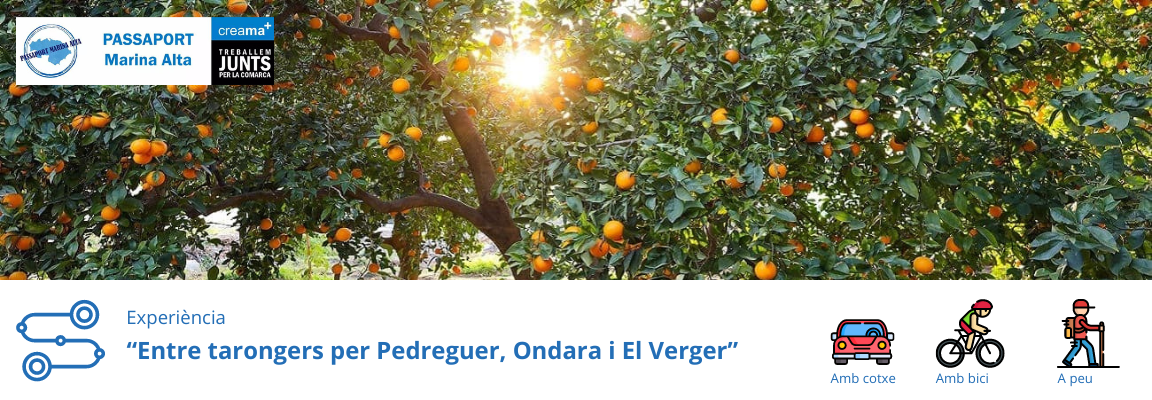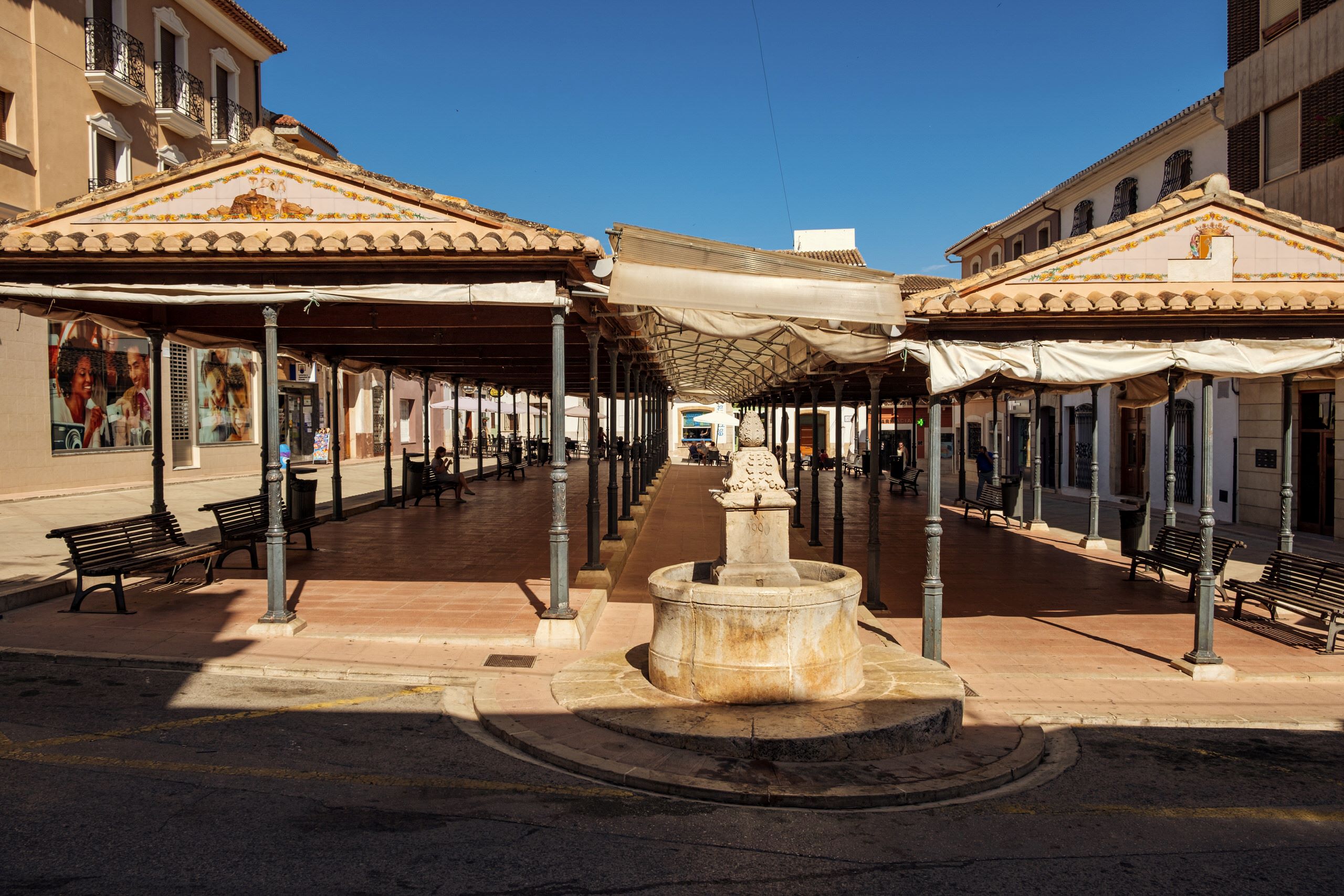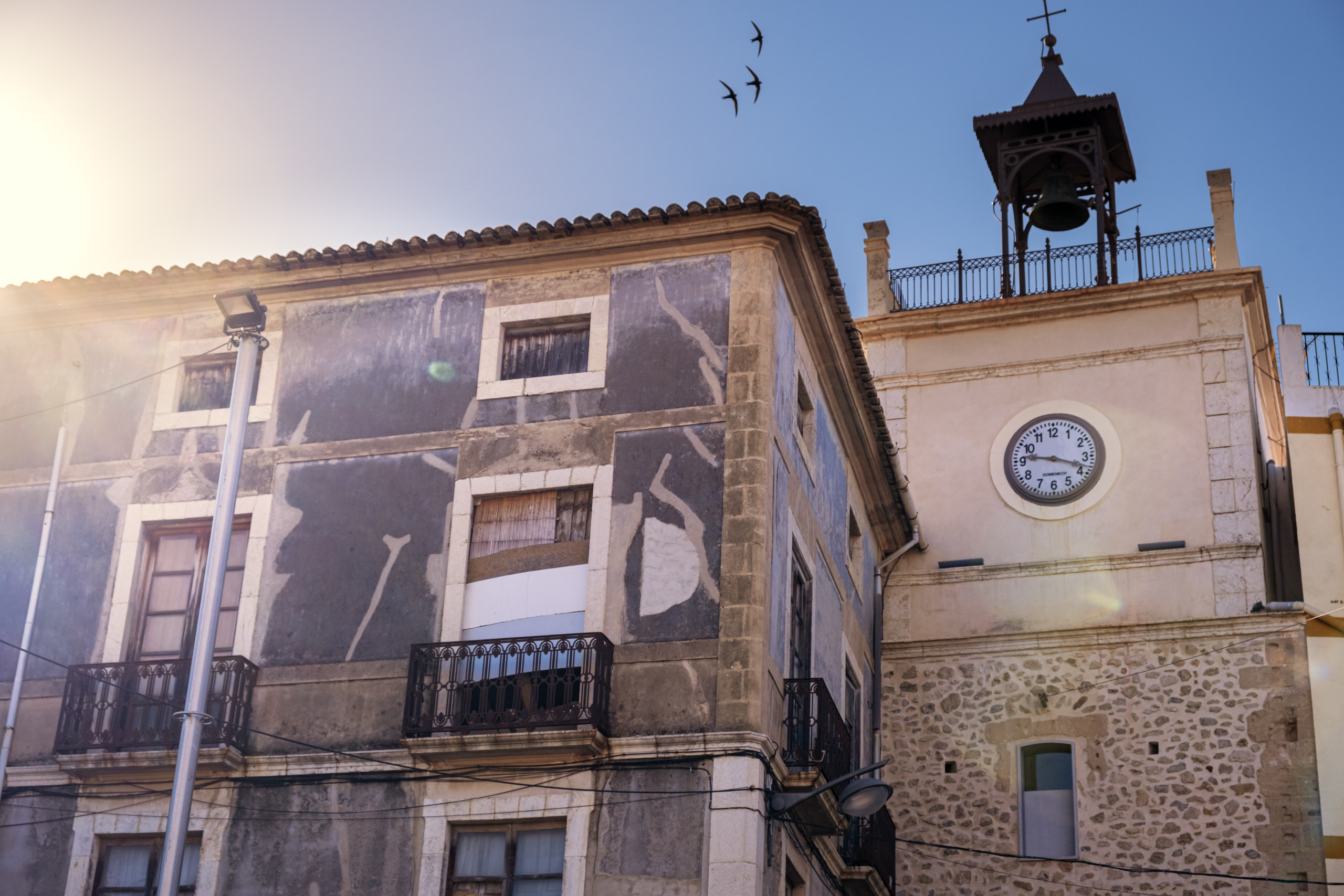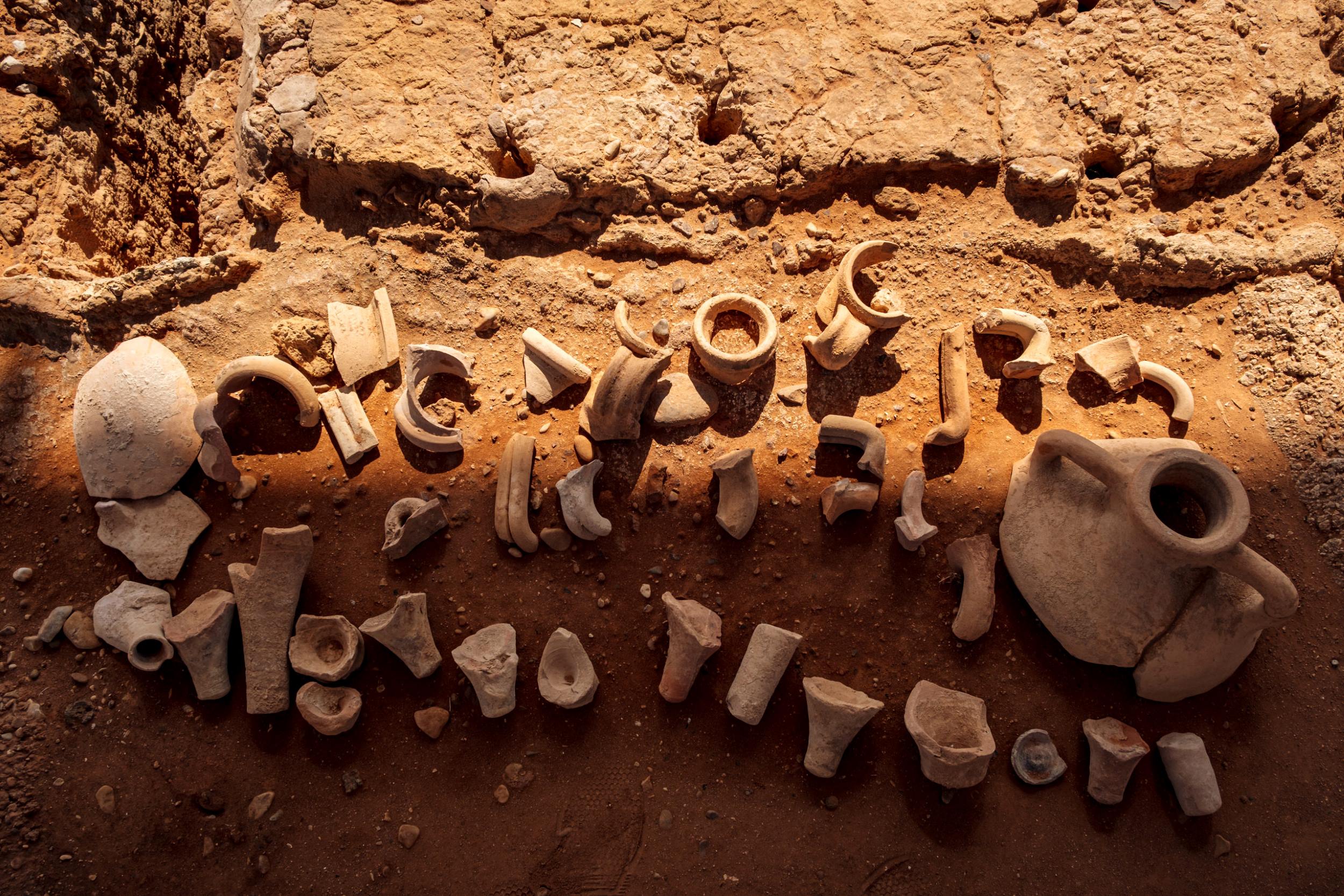This month the colleagues of Passaport Marina Alta propose that we try one of their routes-experiences, it is their proposal: Between orange trees to Pedreguer, Ondara and El Verger. In this route-experience, the agricultural landscape of orange trees is the main character. We propose a gentle walk along paths and roads that are not very busy, where the day-to-day life of the people who cultivate and work these trees goes by.
Marina Alta passport

You can also download and check the complete info at the following link:
[Downloadable PDF]

For this reason, the MACMA team put our rucksacks on our backs and went to explore it, following the directions of the Marina Alta Passport. And this was the result; stage by stage and village by village, we will reveal to you the history and curiosities of the places we have visited on this excursion, which we have enjoyed a lot, and now we hope you will too.
A BIT OF HISTORY. We know where we come from to decide where we are going.
From the MACMA, the experience that we have planned for the month of March has to do with the agricultural landscape. A route that you can enjoy with all 5 senses. The smell of the orange blossom, the taste of the wines and liquors from our land, hear the sound of the waves when they crash against the stones of the sea. Enjoy the view of the landscape of the plain covered with blossoming orange trees. Or notice with the touch the fabrics and materials of the leather goods.
This excursion allows you to get to know four towns in our region, Pedreguer, Ondara, El Verger and Els Poblets.
In this case, the plot thread of the excursion will be the orange groves. And why are we offering it in March? This is the month in which some varieties of orange begin to bloom. Time when the aroma of the flower is associated with the arrival of good weather.
The arrival of orange trees in the territory dates back to the arrival of the Muslims in the 10th century, but they are not the same orange trees that we know today. The first variety they introduced was Citrus aurantium , a type of bitter orange, which was used both for liqueurs and jams, and for decorating gardens for its flower and aroma. It wasn't until the 15th and 16th centuries that the Citrus sinensis variety , the first sweet oranges, arrived from Italy and Portugal . In the 20th century, the vast majority of cultivated varieties were white, blood and Washington Navel oranges, the latter arriving from the United States in 1910.
Regarding the cultivation of citrus fruits in the Marina Alta, it did not begin to take on importance until the end of the 19th century. At that time, the second plague of phylloxera forced many of the farmers to change the type of cultivation, from orange raisin. This fact only occurred in those towns that allowed the implantation of irrigated crops, which are mainly concentrated on both sides of Segària, with the entire Girona basin, the Pego valley, Atzbia and Forna.
As a result of this fact, the citrus trade was increasingly important in a large part of the region. The citrus trade reached a point of great expansion at the beginning of the 20th century, characterized by the international export of the product, as New York and United Kingdom. Thanks to the decision they made to change the type of cultivation, many families in the area were able to afford to build houses and pursue university studies. Currently, we can still see some houses that were built during the expansion of this citrus tree.
Curiosities:
- Basquet: crate that was used to transport the crop product, such as oranges or other harvested fruits. This name is an Anglicism that comes from the word basket, and has remained in our region following the export of this product to English-speaking countries.
- The boys and girls loved blood oranges. They kneaded them with their hands, then cut the top of the orange off and sucked it. It was like a treat for them, as it’s a very sweet variety with a certain strawberry aftertaste.
- It was possible to buy oranges from the producers themselves, who were next to the roads and trails, at the entrance of their orchards. Even today we can buy oranges, limes, and tangerines in stalls on the edge of road N332.

PROPOSED DAYS. Step by step we are making our way.
The excursion will start from Pedreguer, specifically from the “Sequier” roundabout (roundabout where Constitució Ave, Ausiàs March Ave, País Valencià Ave and Tirant lo Blanc St intersect). This is a good place to park.
In the roundabout you will be able to observe the iron sculpture of the Xàbia artist Toni Marí. It is a sequier, a fundamental element for the distribution of water towards the orange groves. The ditches are an irrigation system made up of complex networks, in which the main canal takes water from its place of origin and supplies the daughter canals. The sequier is opening a split or canal to irrigate "a manta", the scene is accompanied by a lantern, since the sequier started working still at night and is accompanied by a faithful companion, his dog. The entire scene is framed by vineyards and orange trees, in clear allusion to the change from dryland to irrigated that we mentioned earlier. In addition, the Els Pòrxens cultural association has recently premiered the documentary 'Sequiers: The water craft in Pedreguer' (soon to be available online).
Then, we will walk in a straight line along Constitució Ave (direction to the city centre) and along Mestre Serrano St until we reach Major Sq. In the square we will find the church of Santa Creu de Pedreguer, the current parish church of the municipality, and the Pòrxens, a construction from the end of the 19th century. It was built with the purpose of providing cover for the municipal market, which is still celebrated every Saturday.

We will continue our excursion in the direction of the Hermitage of Sant Blai, passing through the classic zigzag path of Calvary (also accessible by car). This chapel was built in the second half of the 18th century, although it was rebuilt due to a fire that caused a lot of damage. From this point, a little higher, we can appreciate the town of Pedreguer and the whole plain that surrounds it with the cultivation of oranges.
Then we will go down other streets to Gabriel Miró Street, where the Casa Municipal de Cultura is located , which used to be the school until the 1990s, when it changed its use. Right in front we find the Glorieta de la Creu with the monument in Homage to the Barxeres, who are those women who worked tin in the municipality.
While walking through the streets of this town, before going to the next one, it is recommended that you stop by some shops where you can purchase leather goods and handicrafts.
Finally, we recommend that you finish the visit by going to the Abeurador i Font. A monument built in 1958 and which main function was to supply water to the population and animals, it is located at one of the entrances to the municipality.
Once we have seen the town of Pedreguer and some of the most emblematic elements of the municipality, we will go to the next one, Ondara.
A place where we can easily park the car is the free car park on Carrer Nacions sense Estat. Then we will walk to observe the exterior of the Bullring, inaugurated in 1901 with the aim of creating the only bullring between Valencia and Alicante. We have an emblematic building with which to see and appreciate the period of economic abundance in La Marina Alta with the production of raisins.
If we continue outside the square, right next to it, we will find the Prado, a building from the 1950s intended for the municipal market for local products. It was one of the most important supply markets between Alicante and Valencia, in addition to El Prado de Gandia . Today, the market continues to take place every Wednesday outside the grounds with stalls of pickles, pickled vegetables, fruit and vegetables, meat and many other products.
We will then cross the bridge and find ourselves in the convent square, where we can see the Font de la Carxofa, built in the 19th century to supply drinking water to the entire municipality. Next to the Fountain we can see the Town Hall, former convent of the Minims and the town's House of Culture. Just behind there's the main square, where the Clock Tower is located, the only defensive tower left standing of the Castle-palace of Ondara.

Finally, walking through the streets of the locality, we will arrive at the Llavador d'Ondara and l'Assut, a small stone dam, of Muslim origin, which helps to carry the water towards a canal or ditch.
It is very important not to leave this town without making a stop to visit the different wineries and taste the wines and spirits that the town has. We recommend that during the route, you pass by these and taste some local products.
Once we have passed the second stop of the excursion, we will take the car and head to the next municipality, El Verger.
We will leave the car on La Via avenue, which is where we will make the first stop in the municipality, at the old railway station and current Local Police depot. From the outside, you can see the historic 1880 structure of the train stop that went from Carcaixent to Dénia.
Very close to this first stop, you will find a site from the 16th century, called Casa del Trapig. You can appreciate the remains of the mill that transformed sugar cane into molasses.
From this stop, walk along the banks of the Girona river until you reach Carrer de l'Abadia. There, you will stop to see the Torre dels Ducs de Medinaceli , the only original remnant left of the late Palau del Marqués from Dénia. In the same place you can find the church of Mare de Déu del Roser, a neoclassical style temple built in the 18th century. Behind this the house from the beginning of the 20th century, called Senyoreta de la Bassa. Three streets ahead of the church, you can see the old Soap Factory , where, nowadays, it is used as a cultural centre where various activities are organized.

Finally, on the way to the car, we will cross the town again and take the opportunity to stop at one of the Verger bakeries. You can buy savoury cakes, sweet cakes and some traditional cakes and food from the town and the region.
The last stop by car is Els Poblets, a municipality made up of three towns, Setla, Mira-rosa and Miraflor which are located in the coastal area of the Marina Alta. To park, we can go to the Cervantes street car park and from here we will enter the last section of the experience.
First, we recommend walking to Almadrava beach along the Camí de les Revoltes, a walk full of nature and tranquillity next to the Girona river. Along this path we will reach a very quiet stone beach. On the right-hand side of the river we will find the Torre de l'Almadrava, a defensive tower built in the middle of the 16th century and the northernmost tower in the province of Alicante. From here, by the sea in a northerly direction, we will be able to see the stone of El Salvador and the Roman Site of l’Almadrava, remains of a rustic establishment with activity between the 1st and 5th centuries AD.

Finally, we will walk back to Els Poblets to finish visiting the church of Sant Josep and the church of Diví Salvador, the oldest, established as the only parish in the municipality at the moment.
To complete this experience full of emotions, history, and culture of our region, we suggest you eat in a typical tapas bar of the region.
**This experience is designed to be done in a single day, although each person can adapt it to their abilities and physical resistance. From the MACMA we recommend that the route be done on a Wednesday to be able to enjoy the Ondara El Prado market. If you want to extend your experience and visit other places related to the orange, you can visit the Cooperative and the Ethnological Museum of Pego. In addition, if what you want is to expand the information or elements to visit in each town, you can go to the Descobrim la Marina Alta website and customize this route.

AND MORE. On the table and in bed at the first cry.
 Where to buy |  where to eat |
 where to sleep |  Activities and others |